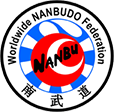Yoshinao Nanbu.
Yoshinao Nanbu, was born in 1943 in Kobe, Hyogo Prefecture, Japan. He grew up in an environment where Budo is a family tradition. To go back only to his great grandfather, he was a famous Sumoka (Yokozuna), covering many pages of the rich history of Japanese sumo at Ryokugikan, the home of Sumo in Tokyo.
At the early age of five years old, Yoshinao Nanbu began learning Judo at his father’s Dojo, who was training the Kobe Police Force. After a few years, he also started studying Japanese weapons (kendo, iaido, battodo) with an uncle. Another uncle as well was practicing judo and his mother was an expert in Naginata!
At the age of 18, when he was admitted as a student at the Osaka University of Economics, he discovered karate there. At that time, Shito-ryu was the karate practiced in the Kansai region. He followed the teachings of Sensei Tani and Tanaka.
In 1963, he won the title of University Team Champion, and beat the very famous Akiyama by K.O. (it was allowed at that time). He was proclaimed the best fighter of the event to which 1250 competitors were participating.
Then, from April 1963 to March 1964, he became captain and coach of the university team of the Osaka University Karate Club.
Henry Plée (1923-2014), a pioneer of French and European Karate, founder in 1955 of the Dojo: Karate Club of France also known as “Dojo de la Montagne Sainte-Geneviève” in the center of Paris invited Yoshinao Nanbu. He had seen him at the Tani sensei dojo, one of the strongest figures in Japanese karate, as well as a captain of a Japanese karate team.
Yoshinao Nanbu teaches there judo in the morning, aikido in the afternoon and karate in the evening! In 1964, he was captain of the club and won the French championship in team. In 1965, he won the French Cup in individual. He also won the International Cup of Cannes in 1966.
Yoshinao Nanbu returned to Japan in 1968. He wanted to enrich his technique and his knowledge of Budo. It was precisely during this year that his teacher Chojiro Tani entrusted him with the mission of developing Shukokai Karate in Europe and organizing world championships of this style. He fulfilled this mission with enormous success and broke up the day after these championships with the Shukokai.
Shukokai was a karate very geared toward competition, which Yoshinao Nanbu had appreciated at one point. But this style seemed then too rigid to him, and he preferred to avoid using force against force, to dodge, to counterattack stronger. Disagreeing with Tani Sensei, he was forced to leave, and at 27 years old, he created his own method and called it Sankukai.
But he had already warned his students that it would be a step towards something else.
Still deploring too much stiffness in movements, he said in an interview with the magazine Karate at the beginning of Nanbudo: “Syncopated and rigid movements are replaced by natural, flexible gestures, the rhythm is much smoother. We seek harmony through circular movements. The circle absorbs the strength of the partner and associates it with ours. ”
His dissatisfaction also lasted since he had stopped competition. He writes in his book, Nanbudo yin techniques n ° 1, after recalling the competitions in which he had participated: “I had nothing more to prove, I looked for something else. And I kept looking for ways to acquire a strong mind. I created exercises to receive the energy of Ki and I worked out the seven forces which are fundamental to strengthen the spirit, to be convinced again and again of its force of courage, of judgement, etc. and finally if I look back, today I am a thousand times, ten thousand times stronger than before. ”
Nanbudo was born in 1978.
Since the creation of Nanbudo in 1978, Yoshinao Nanbu Doshu Soke has continued to refine his art by regularly going all over the world to conduct Nanbudo seminars in different countries.
He passed away on April 28, 2020 having bequeathed the Nanbudo and set up a World Nanbudo Federation and made a certain number of arrangements so that the Nanbudo can continue to live, develop and evolve.



